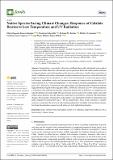Por favor, use este identificador para citar o enlazar a este item:
http://hdl.handle.net/10261/227925COMPARTIR / EXPORTAR:
 SHARE SHARE
 CORE
BASE CORE
BASE
|
|
| Visualizar otros formatos: MARC | Dublin Core | RDF | ORE | MODS | METS | DIDL | DATACITE | |

| Título: | Native Species Facing Climate Changes: Response of Calafate Berries to Low Temperature and UV Radiation |
Autor: | Romero-Román, María Eugenia; Schoebitz, Mauricio; Bastías, Richard M.; Fernández, Pablo S.; García-Viguera, Cristina CSIC ORCID ; López-Belchi, María Dolores | Palabras clave: | Native Chilean berry Antioxidant activity UV radiation Temperature influence PCA Food security Climate change |
Fecha de publicación: | 19-ene-2021 | Editor: | Multidisciplinary Digital Publishing Institute | Citación: | Foods 10(1): 196 (2021) | Resumen: | Calafate (<i>Berberis microphylla</i> G. Forst) is a wild bush plant widely distributed in the south of Argentina and Chile. Their blue colored fruits present particular flavor and health benefits attributed to high polyphenol contents biosynthesized by the plant under stress. Studies about correlation of abiotic conditions with anthocyanin profiles and physicochemical features of calafate beneath wild origin environment are not described yet. Hence, this research aimed to evaluate the physicochemical changes, antioxidant activity and anthocyanin content of calafate fruit in relationship to UV solar radiation (W.m<sup>−2</sup>) and air temperature (°C) environment condition during three consecutive years (2017, 2018, 2019). Variations in fruit anthocyanins were determined by comparison between high performance liquid chromatography (HPLC-DAD-ESI)/MSn and <i>CIEL*a*b*</i> colors parameters. Correlations were analyzed by principal component analysis (PCA). Radiation was negatively correlated with fruit size and weight. Physicochemical aspects such as pH, soluble solids, color, total anthocyanins, flavanols and other phenolic compounds were positively correlated with temperature changes. The quantities of monomeric anthocyanins were dependent on both low temperature and global radiation (reaching 20.01 mg g<sup>−1</sup> FW in calafate fruit). These results constitute a valuable resource to understand the structural and physiological plasticity of calafate in facing climate changes for future domestication research as well as for agri-food industrial application. | URI: | http://hdl.handle.net/10261/227925 | DOI: | 10.3390/foods10010196 | E-ISSN: | 2304-8158 | Identificadores: | doi: 10.3390/foods10010196 |
| Aparece en las colecciones: | (CEBAS) Artículos |
Ficheros en este ítem:
| Fichero | Descripción | Tamaño | Formato | |
|---|---|---|---|---|
| foods-10-00196.pdf | 1,23 MB | Adobe PDF |  Visualizar/Abrir |
CORE Recommender
SCOPUSTM
Citations
12
checked on 14-may-2024
Page view(s)
107
checked on 16-may-2024
Download(s)
104
checked on 16-may-2024
Google ScholarTM
Check
Altmetric
Altmetric
Este item está licenciado bajo una Licencia Creative Commons



